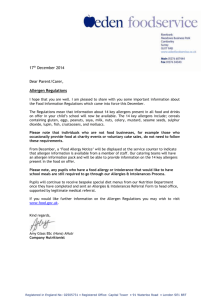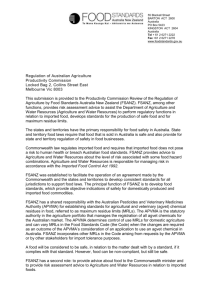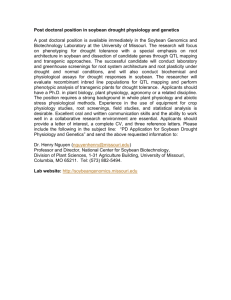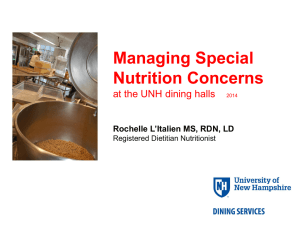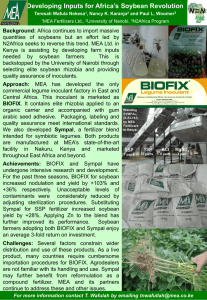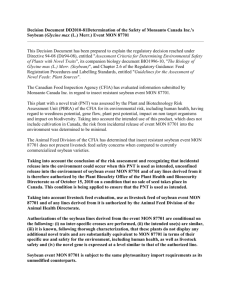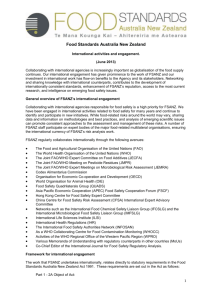Proposal P1031 - Food Standards Australia New Zealand
advertisement
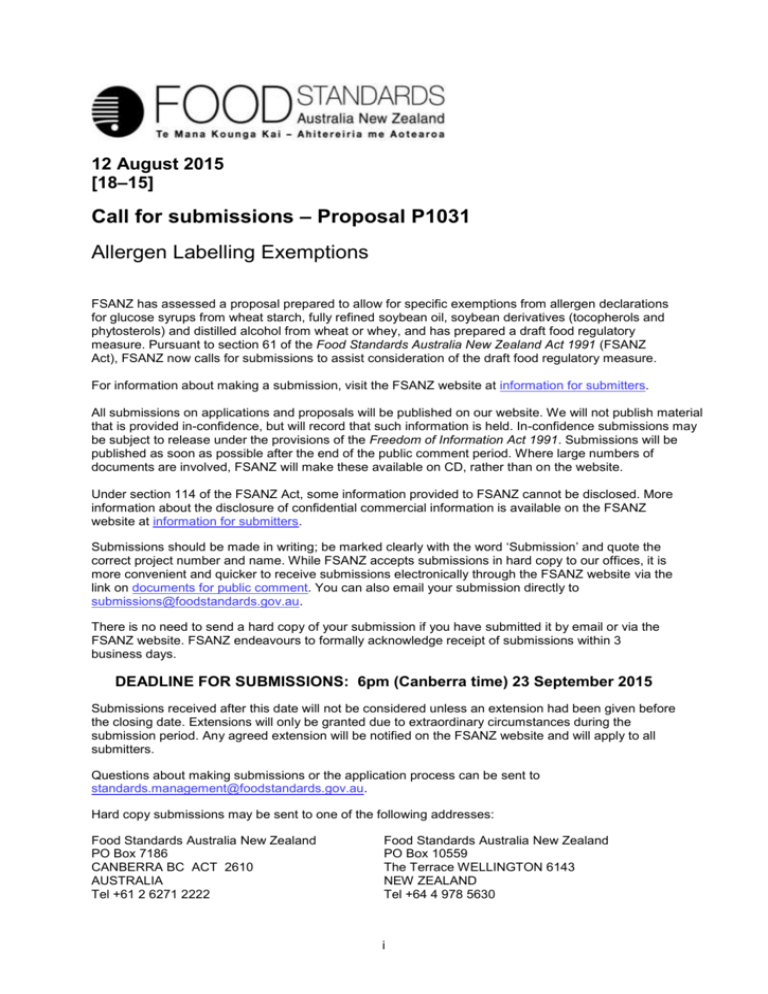
12 August 2015 [18–15] Call for submissions – Proposal P1031 Allergen Labelling Exemptions FSANZ has assessed a proposal prepared to allow for specific exemptions from allergen declarations for glucose syrups from wheat starch, fully refined soybean oil, soybean derivatives (tocopherols and phytosterols) and distilled alcohol from wheat or whey, and has prepared a draft food regulatory measure. Pursuant to section 61 of the Food Standards Australia New Zealand Act 1991 (FSANZ Act), FSANZ now calls for submissions to assist consideration of the draft food regulatory measure. For information about making a submission, visit the FSANZ website at information for submitters. All submissions on applications and proposals will be published on our website. We will not publish material that is provided in-confidence, but will record that such information is held. In-confidence submissions may be subject to release under the provisions of the Freedom of Information Act 1991. Submissions will be published as soon as possible after the end of the public comment period. Where large numbers of documents are involved, FSANZ will make these available on CD, rather than on the website. Under section 114 of the FSANZ Act, some information provided to FSANZ cannot be disclosed. More information about the disclosure of confidential commercial information is available on the FSANZ website at information for submitters. Submissions should be made in writing; be marked clearly with the word ‘Submission’ and quote the correct project number and name. While FSANZ accepts submissions in hard copy to our offices, it is more convenient and quicker to receive submissions electronically through the FSANZ website via the link on documents for public comment. You can also email your submission directly to submissions@foodstandards.gov.au. There is no need to send a hard copy of your submission if you have submitted it by email or via the FSANZ website. FSANZ endeavours to formally acknowledge receipt of submissions within 3 business days. DEADLINE FOR SUBMISSIONS: 6pm (Canberra time) 23 September 2015 Submissions received after this date will not be considered unless an extension had been given before the closing date. Extensions will only be granted due to extraordinary circumstances during the submission period. Any agreed extension will be notified on the FSANZ website and will apply to all submitters. Questions about making submissions or the application process can be sent to standards.management@foodstandards.gov.au. Hard copy submissions may be sent to one of the following addresses: Food Standards Australia New Zealand PO Box 7186 CANBERRA BC ACT 2610 AUSTRALIA Tel +61 2 6271 2222 Food Standards Australia New Zealand PO Box 10559 The Terrace WELLINGTON 6143 NEW ZEALAND Tel +64 4 978 5630 i Table of Contents EXECUTIVE SUMMARY............................................................................................................................... 2 INTRODUCTION ................................................................................................................................... 3 1 1.1 THE PROPOSAL ..................................................................................................................................... 3 1.2 THE CURRENT STANDARDS ................................................................................................................... 3 1.3 REASONS FOR PREPARING THE PROPOSAL.......................................................................................... 3 1.3.1 Allergen Review .............................................................................................................................. 4 1.3.2 Preliminary information .................................................................................................................. 4 1.4 PROCEDURE FOR ASSESSMENT ............................................................................................................ 4 SUMMARY OF THE ASSESSMENT ................................................................................................... 4 2 2.1 RISK ASSESSMENT ................................................................................................................................ 4 2.1.1 Soybean oil ...................................................................................................................................... 5 2.1.2 Phytosterols and tocopherols ....................................................................................................... 5 2.1.3 Glucose syrup derived from wheat .............................................................................................. 5 2.1.4 Alcohol distillates from wheat and whey ..................................................................................... 6 2.2 RISK MANAGEMENT ............................................................................................................................... 6 2.2.1 International practice on allergen labelling ................................................................................. 6 2.2.2 Products under consideration for labelling exemption .............................................................. 7 2.2.3 Consequential impact .................................................................................................................. 10 2.2.4 Potential changes to allergen declarations ............................................................................... 10 2.3 RISK COMMUNICATION......................................................................................................................... 11 2.3.1 Consultation................................................................................................................................... 11 2.3.2 World Trade Organization (WTO) .............................................................................................. 11 2.4 FSANZ ACT ASSESSMENT REQUIREMENTS ....................................................................................... 12 2.4.1 Section 59 ...................................................................................................................................... 12 2.4.2. Subsection 18(1) ...................................................................................................................... 13 2.4.3 Subsection 18(2) considerations ................................................................................................ 14 DRAFT VARIATIONS TO THE CODE .............................................................................................. 15 3 3.1 TRANSITIONAL ARRANGEMENTS.......................................................................................................... 15 ATTACHMENT A – DRAFT VARIATION TO THE AUSTRALIA NEW ZEALAND FOOD STANDARDS CODE ............ 16 ATTACHMENT B – DRAFT EXPLANATORY STATEMENT.................................................................................... 18 Supporting documents The following documents which informed the assessment of this Proposal are available on the FSANZ website at http://www.foodstandards.gov.au/code/proposals/Pages/P1031Allergenlabellingexemptions.a spx SD1 SD2 Risk assessment International Exemptions 1 Executive summary Under the Australia New Zealand Food Standards Code (the Code), any food product wholly or partially derived from an allergenic source must declare the allergen (with some limited exemptions), either on the label or, for foods not required to carry a label, in other ways as prescribed in the Code. FSANZ is proposing to exempt certain foods and ingredients derived from allergenic foods from mandatory declaration of allergens where available evidence indicates the production methods used remove or reduce allergenic proteins to levels that are of negligible risk to allergic consumers. FSANZ, together with a working group from the Australian Food and Grocery Council’s Allergen Bureau, has identified four products for consideration for exemption from mandatory labelling requirements for allergens: soybean oil that has undergone a complete refining treatment tocopherols and phytosterols derived from the deodoriser distillate of fully refined soybean oil glucose syrup derived from wheat starch alcohol distillate made from wheat or whey. The proposed exemption would widen the range of products available to allergic consumers and benefit industry and regulatory agencies. These products are exempted by the European Union (EU) based on specified production methods, and either are, or may be, eligible for exemption from the United States of America (USA) and Canada based on absence of allergenic protein or scientific demonstration that they do not cause an allergic response. FSANZ has conducted a risk assessment and concluded that soybean oil that has been fully refined i.e. degummed, neutralised, bleached and deodorised (N/RBD) presents negligible risk to soybean allergic consumers. Tocopherols and phytosterols are removed in the last stage of refining of soybean oil and therefore also present negligible risk. Similarly, alcohol distilled from wheat or whey presents negligible risk to susceptible individuals. The risk assessment concluded that based on available evidence, wheat-derived glucose syrup that has been processed so that it contains equal to or no more than 10 mg gluten/kg glucose syrup is considered safe for consumption by sensitive wheat allergic individuals. FSANZ consulted with allergy specialists across Australia and New Zealand on the risk assessment for this Proposal and they identified there is sufficient evidence to support FSANZ preparing a Proposal to vary the Code to allow for certain exemptions to allergen declarations. Two options were considered as part of the assessment of this Proposal: preparing a draft variation to Standard 1.2.3 and consequential amendments (Option 1) abandoning the Proposal (Option 2). The proposed draft variations (Option 1) are only for the revised Code which comes into operation on 1 March 2016. It was felt unnecessary to amend the current Code which will be replaced at that time. Gazettal is expected to be soon thereafter. A limited impact analysis of the cost and benefits has been prepared which indicates Option 1 provides the greatest net benefit. If the proposed changes are adopted, the current mandatory allergen declarations for the products under consideration would no longer be required. 2 1 Introduction 1.1 The Proposal FSANZ is proposing to exempt certain foods and ingredients derived from allergenic foods from mandatory declaration of allergens where available evidence indicates the production methods used remove or reduce allergenic proteins to levels that are of negligible risk to allergic consumers. 1.2 The current Standards Section 4 of Standard 1.2.3 – Information requirements – warning statements, advisory statements and declarations, for both the current and revised Australia New Zealand Food Standards Code (Code) requires declarations to be made for any food product wholly or partially derived from an allergenic source to be labelled (with some exemptions). Allergenic sources include cereals containing gluten, crustacea, egg, fish, milk, peanuts, sesame seeds, soybeans and tree nuts. For products that are not required to bear a label, e.g. those that are served direct to consumers or unpackaged for other reasons, declarations are required to be made on or in connection with the food, or provided to the purchaser upon request (refer to section 9 of Standard 1.2.1 – Requirements to have labels or otherwise provide information in the revised Code) or for food sold to a caterer, provided on a label or in accompanying documentation (refer to Standard 1.2.1 in the revised Code, sections 15 and 16 respectively). For the purposes of this document, general discussion about products being labelled should also be taken to include those products that are not required to bear a label. Of particular relevance to this Proposal are the requirements to declare wheat and its products, soybean and soybean products, and milk and milk products; when present as: (a) (b) (c) (d) an ingredient; or an ingredient of a compound ingredient; or a food additive or component of a food additive; or a processing aid or component of a processing aid. Standard 2.9.5 and Schedule 10 of the revised Code also provide for allergen declarations. Standard 2.9.5 – Food for special medical purposes addresses allergen declaration requirements by cross-referencing Standard 1.2.3. Schedule 10 – Generic names of ingredients and conditions for their use requires in the context of otherwise generically labelled fats and oils that, where the source is peanut, soybean or sesame, the specific source name must be declared. The requirement pertaining to soybean oils is relevant to this Proposal. 1.3 Reasons for preparing the Proposal There is evidence that some products that must be declared under Standard 1.2.3 do not pose a risk to allergic consumers. As a consequence, food choice for allergic consumers is unnecessarily restrictive and the current labelling requirements are unnecessarily onerous for industry and regulatory agencies. Additionally, Australian and New Zealand industries face market limitations and trade issues that hamper international competiveness, because of exemptions to allergen declarations that are already in place (especially in Europe and North America). 3 1.3.1 Allergen Review A Review of the Regulatory Management of Food Allergens (Allergen Review) by FSANZ, published in December 20101, considered the issue of exemption of ingredients derived from allergenic foods. A key recommendation from the Review was for: FSANZ to consider, on a case-by-case basis, the scientific and clinical data available on the allergenicity of food ingredients derived from allergenic sources. Ministers responsible for food regulation endorsed the review and its recommendations in 2011, including that FSANZ ...in consultation with the food industry, develop options to reflect the evidence base through guidance and/or regulatory amendments. This Proposal seeks to implement the Ministers’ recommendation. 1.3.2 Preliminary information The Environmental Science and Research funded by the New Zealand Ministry for Primary Industries (MPI) undertook and reported on two analytical surveys of levels of residual protein in alcohol derived from wheat and whey, glucose syrup and fully refined soybean oil. FSANZ was involved in identifying potential foods, visiting manufacturing sites, considering processes and organising provision of samples for the two surveys. FSANZ met with members of the Australian food industry through a dedicated Working Group established by the Allergen Bureau to facilitate work on possible exemptions. The Working Group provided a prioritised list of ingredients for FSANZ to consider for exemption. The FSANZ risk assessment for each of the prioritised ingredients considered published and unpublished scientific studies along with analytical data from FSANZ/MPI projects and the European Food Safety Authority (EFSA) review of exemptions. The outcome of these risk assessments was that these nominated ingredients would pose a negligible risk to the majority of allergic consumers. These findings were supported by the Food Allergy and Intolerance Scientific Advisory Group (FAISAG). The FAISAG was established by FSANZ and includes allergy clinicians from Australia and New Zealand who are recognised as experts in their field. From these risk assessments it was considered there was sufficient evidence to support preparing a Proposal to vary the Code to allow for certain exemptions to allergen declarations. 1.4 Procedure for assessment The Proposal is being assessed under the General Procedure. 2 Summary of the assessment 2.1 Risk assessment The risk assessment in this report relates to four products derived from allergenic foods. The products are: soybean oil that has undergone a complete refining treatment further referred to in this documentation as fully refined or N/RBD oil i.e. it has been degummed, neutralised, bleached and deodorised; tocopherols and phytosterols derived from the deodoriser distillate of N/RBD soybean oil; glucose syrup from wheat starch; and alcohol distillate from wheat or whey. The full risk assessment is provided in Supporting Document 1 (SD1). 1http://www.foodstandards.gov.au/consumer/foodallergies/review/documents/Review%20of%20the%20Regulator y%20Management%20of%20Food%20Allergens-FSANZ%20Dec%202010.pdf 4 Food allergens are almost always proteins but not all proteins are allergens. As a result the risk of an allergic (IgE mediated) response in any food allergic individual will be dependent on some threshold protein dose. As this threshold dose is different for each individual the amount of allergy-causing protein remaining in a refined product and the quantity of such food consumed are important considerations. Various refined products derived from allergenic foods, such as soy and wheat, contain only a trace or undetectable amounts of total (ie. allergenic + non-allergenic) protein as a result of the extensive chemical and/or physical processing. Products prepared by such processing will minimise the risk of an allergic response in susceptible consumers. FSANZ considered published and unpublished oral food challenge studies in allergic patients for each of the refined products. Analytical data on residual protein levels in samples from each of the refined products were also considered. Dietary exposure per meal was estimated based on the level of use in food and food consumption data. The assessments also considered information about the processing steps which could reliably reduce the protein content in the final product. Input from specialist allergy clinicians in Australia and New Zealand was obtained through consultations with the FAISAG. In particular, FSANZ sought advice on suitable terminology to describe the level of risk, and what conclusions could be drawn from the available evidence. 2.1.1 Soybean oil The risk assessment concluded that N/RBD soybean oil presents negligible risk to soybean allergic consumers. The conclusion is based on the negative results of clinical studies of dose escalation oral challenges, with analytical data showing extremely low / undetectable protein content in N/RBD soybean oil, and the limited dietary exposure to soybean oil which may occur in one meal. N/RBD oil is virtually devoid of any protein as a result of the processing steps required to produce such oils. 2.1.2 Phytosterols and tocopherols Phytosterols and tocopherols, which are highly processed products derived from the soybean based deodoriser distillate, were considered. The distillate is generated in the final step of N/RBD soybean oil production. Analytical data confirmed that protein was not detected in the distillate and tocopherols, phytosterols are also unlikely to contain detectable protein. This is not surprising since soybean protein is removed in the production of N/RBD soybean oil. It follows then that, like N/RBD soybean oil, tocopherols and phytosterols present negligible risk to soybean allergic consumers. 2.1.3 Glucose syrup derived from wheat The available clinical data suggests that acute dietary exposure (a single eating occasion) to no more than 1 mg of wheat protein is unlikely to provoke an IgE-mediated immunological response in the majority of wheat sensitive individuals. Australian food consumption data for 7-16 year olds indicates that between 75-91 g of confectionery may be eaten in a children’s birthday party scenario, hence a single meal consumption of 100 g confectionery was taken to be a high consumer amount for children. Wheat protein exposure from glucose syrup in confectionery will depend on its residual protein level, and is measured as gluten where the total protein:gluten ratio is approximately 1:0.75. For example, for a gluten level of 20 mg/kg, 75 g confectionery would contain 1 mg wheat protein; whereas for a gluten level of 10 mg/kg, 150 g of confectionery would contain 1 mg wheat protein. Analytical data from Australian produced glucose syrup shows that in 95% of samples tested, gluten levels were below the limit of detection (˂3 mg/kg). 5 Therefore, minimising gluten in all glucose syrup samples to as low as technically and practically achievable (i.e. ≤10 mg/kg), would ensure that dietary exposure for consumers does not exceed 1 mg of wheat protein in a single meal. The risk assessment concluded that based on the available evidence, consumption of wheat-derived glucose syrup that had been purified and prepared as described in Appendix 2 would present negligible risk to the majority of wheat allergic individuals; such syrups would also be suitable for those with coeliac disease. 2.1.4 Alcohol distillates from wheat and whey Another category of products considered in this risk assessment is distillates from wheat and from whey (a milk product). There is general scientific agreement that, in a properly controlled distillation process, non-volatile substances such as lactose and proteins from whey are not found in the distillate. On this basis, distilled alcohol (and products made from distilled alcohol, such as vinegar) would not contain protein. The available analytical data confirm that protein is undetectable (i.e. <1 mg/kg) in distilled ethanol from whey and from wheat. The risk assessment concluded that alcohol distilled from wheat or whey presents negligible risk to susceptible individuals. Question: 1. 2.2 Is there further information about allergic consumers and health and safety aspects that you would like to provide for consideration? If so, please support your comments with appropriate references and/or data. Risk management The risk assessment identifies three products and alcohol distillates from two sources where the levels of protein are so low as to present negligible risks to the majority of susceptible individuals. Where this is so, the need to provide allergen declarations on product labels or as otherwise required may be overly restrictive. This Proposal presents the option of exempting from mandatory declaration the identified products, and any products further derived from those whereby the processes undergone are not likely to increase the allergenicity of the original product. The proposed basis of exemption varies according to the product. For example, for soybean derived tocopherols and phytosterols, and whey or wheat distillates, the processing methods used means the remaining protein is so low as to be undetectable in conventional protein assays. However technically achievable protein limits are being proposed for products where processes are designed to remove protein but small amounts of protein may still remain. In this case the available clinical and scientific evidence indicates that such levels are considered to be within limits safe for consumption by the majority of allergic individuals (e.g. for glucose syrups derived from wheat). The approach of setting limits for purposes of declaration exemptions is not dissimilar to that currently adopted for sulphites, where clinical susceptibility, dietary exposure and technical achievability are taken into account in order to arrive at an acceptable level for the purposes of declaration on the label. 2.2.1 International practice on allergen labelling International discussions on food allergens started in the mid-1990s and led to the development of standards first by the Codex Alimentarius (Codex) in 1999, followed by a number of countries including Australia and New Zealand (2000), EU (2003), USA (2004), and Canada (2011). 6 Although there is a common core list of allergenic foods in these countries the regulatory approaches taken vary, including whether or not certain products are exempt and if so on what basis. For example, in the USA and Canada products may be exempted based on scientifically demonstrated safety for allergic individuals, or absence of allergenic protein as the case may be, and in the EU exemptions are considered based on evidence products do not cause adverse reactions. With regard to the products being considered in this Proposal, the source products, i.e. dairy milk, soybean and wheat, are also identified as allergens by Codex and by many other countries that address allergen labelling e.g. EU, USA, Canada, China, Hong Kong, Japan, Korea and Mexico (Gendel, 20122). Not all countries or Codex provide exemptions. Of those that do, the products being considered here are also exempted by the EU (as part of a list of 13 exemptions) and, based on absence of protein, may be eligible for exemption from the USA and Canada. The USA specifically identifies the exemption of highly refined oils derived from their major food allergens, whereas Canadian requirements only apply to foods containing the component responsible for adverse reactions (i.e. protein). The USA and the EU also provide ways for suppliers to request further exemptions from labelling requirements. For example under the US Food Allergen and Labelling Consumer Protection Act of 2004 (FALCPA) manufacturers may obtain an exemption by submitting a petition that provides scientific information demonstrating that an ingredient derived from a major food allergen does not cause an allergic response that poses a risk to human health; or submitting a notification providing scientific information demonstrating that the ingredient does not contain allergenic protein. Supporting Document 2 (SD2) provides a table outlining labelling exemptions for Australia and New Zealand, the EU, USA and Canada. 2.2.2 Products under consideration for labelling exemption The risk assessment has identified three products and alcohol distillates from two sources that, subject to appropriate production, are considered safe for consumption by the majority of sensitive individuals. These production methods are summarised here with further detail provided in SD1. 2.2.2.1 Fully refined soybean oil Soybean oils undergo several steps in the production process which include cleaning, drying, crushing and solvent extraction. The bulk of soybean protein is removed during degumming, the first step in the process. Residual impurities, including proteins, are reduced further by the neutralising step using alkali, and the bleaching step using activated clay or silica. Finally, the oil is deodorised to remove volatile substances such as odours and off-flavours. The full process results in N/RBD oil being virtually devoid of any protein. Ultimately, the level of protein in the final product depends on the quality and efficiency of the purification steps. Purified oils may be referred to as “fully refined”, “highly refined”, or “purified” but these terms are not consistently or universally used. For the purposes of this assessment summary, the term “fully refined” is used and means oils that have been degummed, neutralised (alkali refined), bleached and deodorised, i.e., chemically refined, with the acronym N/RBD used for the purposes of this report. 2 Gendel SM (2012) Comparison of international food allergen labeling regulations. Regulatory Toxicology and Pharmacology 63:279-285. 7 Cold pressed soybean oils, typically used for flavour, are not chemically refined and therefore retain considerable protein. Cold pressed soybean oil is not included in this proposal. Similarly, soybean oils which have only been degummed, as opposed to fully refined, are not suitable for exemption from allergen labelling declaration. Fully refined soybean-derived oils contain minimal levels of protein (<1 mg/kg) and are suitable for consumption by soybean allergic consumers. In the EU the residual protein levels in fully refined soybean-derived oils are ensured by means of a prescribed production process. FSANZ has considered the processes used for refined soybean oils imported into or produced in Australia and New Zealand and understands these to be N/RBD oils and, as such, contain minimal levels (virtually undetectable) of residual protein. Such oils can be process audited for compliance purposes, and there are a number of specified parameters that are used to distinguish between such oils and their crude or degummed counterparts. Such parameters typically include, but are not limited to, free fatty acids, peroxides and colour. These parameters are generally negotiated between the supplier and purchaser using industry based quality standards, such as those provided by the Australian Oilseeds Federation Inc.3. Ultimately an N/RBD oil must be sufficiently clear, odourless and free of free fatty acids to be fit for purpose and by virtue of this process will contain minimal levels of protein. The production process is shown diagrammatically in Figure 1, Appendix 1, of SD1. 2.2.2.2 Soybean derivatives (tocopherols and phytosterols) Phytosterols are a group of steroid alcohols that occur naturally in plants, including soybean. Tocopherols are a group of methylated phenols many of which have vitamin E activity. Phytosterols and tocopherols are by-products of the processing of vegetable oils, including soybean oil. The final step in oil refining is deodorisation i.e. treatment at high temperatures (steam stripped) and low pressure and recovering the volatiles in a vapour condenser. The production process is shown in SD1 (Figure 1, Appendix 1). Phytosterols are permitted to be added to specific foods (low fat milk, breakfast cereals, yoghurt, cheese and edible oil spreads) in the Code. Due to their structural similarity with cholesterol, phytosterols are added to foods for their properties to reduce absorption of cholesterol in the gut and thereby lower blood cholesterol levels. Soybean-derived tocopherols are mainly used as a food antioxidant to prevent rancidity. The Code permits tocopherols (INS307, 307b, 308, 309) to be added to edible oils and oil emulsions (GMP), infant formula products (10 mg/L) and infant food (300 mg/kg of fat). No data relating to the amount of soybean protein remaining in phytosterol and tocopherol preparations or their potential allergenicity were available to FSANZ. However, information including analytical studies, immunochemical studies and clinical studies was reported in two EFSA Opinions (EFSA 2007b, EFSA 2007c) and has been referred to in preparing this report. Further detail is provided in SD1. Deodorisation is the last step of soybean/vegetable oil refining. The vegetable oil deodoriser distillate (VOD) is rich in phytosterols and tocopherols which can be extracted for use in food. The bulk of soybean protein is removed in the earlier steps of the refining process. Since VOD is a by-product of the final step of N/RBD soybean oil production, it follows that VOD would be expected to contain extremely low levels of protein. This was confirmed by analytical testing of VOD and the phytosterols and tocopherols (EFSA 2007b, EFSA 2007c). 3 http://www.australianoilseeds.com/Technical_Info/standards_manual 8 Although the clinical data on phytosterols and tocopherols were limited, a conclusion can be drawn based on the absence of detectable protein in N/RBD soybean oil using conventional assays. As a result of the above considerations it was concluded that tocopherols and phytosterols derived from deodoriser distillate in the manufacturing of N/RBD soybean oil present negligible risk to soybean allergic consumers and subsequently, are proposed for exemption from the requirement for allergen declaration. 2.2.2.3 Glucose syrup from wheat Glucose syrup derived from wheat retains residual protein, including gluten (glutenins and gliadins). The major manufacturer of glucose syrups in Australia has informed FSANZ that the glucose manufacturing system currently in place is designed to provide <10 mg/kg gluten in 100% of samples, and <5 mg/kg in 90% of samples. Control measures are also implemented in the processing environment to avoid crosscontamination with wheat flour and gluten, and to ensure the product wheat-based glucose syrup consistently meets the minimal gluten content of wheat-derived glucose syrups achieved in Europe of residual gluten content ˂3 mg/kg. In addition, the Australian manufacturer has developed a Code of Practice to ensure the wheat-based glucose syrup consistently meets this minimal gluten content of wheat-derived glucose syrup. Similar to the rationale described above for soybean oils, gluten levels in glucose syrup derived from wheat may be managed by adhering to certain production methods, as is the case in Europe. However, FSANZ is of the view that in taking this approach, manufacturers are restricted to this particular process and no allowance is made for alternative methods or potentially improved processes in the future. Therefore, instead, FSANZ is proposing that a maximum level of gluten in glucose syrup derived from wheat be established. In relation to wheat allergy, available clinical evidence suggests that consumption of 1 mg of wheat protein in a single meal represents the upper limit of that which would protect the majority of wheat allergic individuals. It would also be protective for non-IgE immune mediated Coeliac Disease. Wheat protein exposure from glucose syrup will depend on its protein (measured as gluten) level. For example, for a residual protein level of 20 mg/kg, 37 g glucose syrup would contain the upper limit of 1 mg gluten; for a residual protein level of 10 mg/kg, 75 g of glucose syrup would contain 1 mg. The main Australian glucose syrup manufacturer has indicated that the filtration steps are designed to reduce gluten content to <10 mg/kg (or approx. <13 mg/kg wheat protein assuming the ratio of gluten to total protein in purified glucose syrup is similar to that in wheat). Based on the available clinical evidence and likely single meal consumption, FSANZ concluded that wheat-derived glucose syrup with a gluten content of 10-20 mg/kg is likely to present a negligible risk to the majority of wheat allergic individuals. However, to ensure that gluten levels in glucose syrup are as low as technically achievable, the FAISAG has recommended that manufacturers of glucose syrup from wheat starch be encouraged to prepare syrups with the lowest possible gluten levels. In this case it is proposed that glucose syrup made from wheat starch be exempted from mandatory allergen declaration requirements where the residual gluten content is less than or equal to 10 mg/kg. This level was chosen based on clinical evidence regarding the dietary intake of gluten considered safe for the majority of wheat susceptible individuals, and a conservative approach to the levels of protein that have been reported as readily achievable by manufacturers of glucose syrups derived from wheat. The production process is shown in SD2 (Figure 2, Appendix 2). 9 2.2.2.4 Distilled alcohol from whey and wheat Distillation is used to separate liquids and volatile substances from non-volatile substances, such as proteins and sugars (e.g. lactose from whey), and there is general scientific agreement that these non-volatile substances (i.e. proteins and sugars) are unlikely to be found in the distillate when the process is well-run. As such, the alcohol distillate is safe for allergic consumers. Distilled alcohol derived from cereals or whey is commonly used in alcoholic beverages and for use as a solvent in the formulation of flavours and other food ingredients. Distilled alcohol may be further processed to produce vinegar. Reported analytical data confirm that distilled alcohol from whey and wheat produced under proper controls contain no detectable protein (i.e. <1 mg/kg). The data also confirmed the absence of detectable whey proteins in vinegar derived from whey alcohol. Furthermore, the available analytical evidence indicates that distilled alcohol and vinegar derived from whey presents negligible risk to milk allergic individuals, and distilled alcohol derived from wheat presents negligible risk to wheat allergic and coeliac individuals. On this basis, FSANZ proposes that distillates and their products derived from wheat or whey be exempted from mandatory allergen declaration. Question: 2. 2.2.3 Is there further information about production methods and/or residual protein levels of the substances discussed above that you would like to provide for consideration? If so, please support your comments with appropriate references and/or data. Consequential impact Schedule 10 – Generic names of ingredients and conditions for their use in the revised Code provides for ingredients to be listed by a common, descriptive or generic name. With regard to the generic use of ‘fats or oils’, S10—2 specifies if the source of vegetable oil is peanut, soy bean or sesame–-the specific source name [must be declared]. This provision relates to the allergenicity of these foods (i.e. peanut, soybean and sesame) and therefore, the specific source name of such foods must be declared in the statement of ingredients in accordance with section 4 of Standard 1.2.4 – Information requirements – labelling of ingredients. Logically, the proposed changes to Standard 1.2 3 removing the requirement for allergen declaration for N/RBD soybean oils would also apply to the generic labelling of oils sourced from soybeans. To this end the proposed draft variation to the Code includes a consequential amendment to S10-2 to exempt N/RBD soybean oils from the requirement to name the specific oil (rather than generically identified as vegetable oil). At the same time a typographical error (soy bean as opposed to soybean) will be corrected. The draft variation for this amendment is provided at Attachment A, with the associated Explanatory Note at Attachment B. 2.2.4 Potential changes to allergen declarations If the proposed changes are adopted, mandatory allergen declarations arising from the sources discussed above in sections 2.2.2 and 2.2.3 would no longer be required. However, as the requirements in the revised Code for ingredient labelling (as per Standard 1.2.4 and Schedule 10) and all other requirements for allergen declarations (as per Standard 1.2.3) will remain unchanged, consumers will therefore continue to have adequate information on which to make informed and safe food choices. 10 For example, under Schedule 10 – Generic names of ingredients and conditions for their use, manufacturers have the choice to declare non-allergenic oils generically as ‘vegetable oils’ rather than by their source name (e.g. sunflower oil, canola oil). Whereas oils derived from allergenic sources, such as sesame and peanut, must declare the source of the oil. In the case of oils derived from soybeans, only those meeting the allergen declaration exemption criterion would be eligible to use the generic term. Others must be named as soy/soybean oil. This would include cold pressed soybean oils and any other soybean oils produced in ways that are not fully refined and thereby retain considerable protein. For example, degummed soybean oil would not be exempt. It should also be noted, the proposed variation to the Code is an exemption, not a prohibition, and some manufacturers have cycles for changing labels of a year or more. Therefore, some products may continue to carry the (exempted) allergen declaration at the manufacturers’ discretion, including where there was any doubt about the suitability of the product. Consideration will need to be given to the most effective way to communicate the changes for allergen declarations especially to allergic individuals, to minimise any confusion arising from the changes and reassure consumers of ongoing safety and suitability of product. Questions: 3. Do you have suggestions as to preferred means of communicating these changes to interested parties? 4. Are there other implications for interested parties from the proposed exemptions from allergen declarations that may require consideration? If so, please provide any suggestions you may have as to how these might best be managed. 2.3 Risk communication 2.3.1 Consultation Consultation is a key part of FSANZ’s standards development process. FSANZ has prepared a communication strategy for this Proposal, which includes targeted communication with key stakeholders and the preparation of information for the broader community. FSANZ is also working with key consumer groups and other interested stakeholders on ensuring consumers (in particular) are informed about the proposed changes. All calls for submissions are notified via the FSANZ Notification Circular, media release and through FSANZ’s social media tools and Food Standards News. Subscribers and interested parties are notified about the availability of reports for public comment. 2.3.2 World Trade Organization (WTO) As members of the World Trade Organization (WTO), Australia and New Zealand are obliged to notify WTO member nations where proposed mandatory regulatory measures are inconsistent with any existing or imminent international standards and the proposed measure may have a significant effect on trade. There are relevant international standards as outlined above. However, amending the Code to exempt the identified products from mandatory labelling declarations will mean greater alignment with overseas jurisdictions and as such, will support rather than hamper international trade. Therefore, a notification to the WTO under Australia’s and New Zealand’s obligations under the WTO Technical Barriers to Trade or Sanitary and Phytosanitary Measures Agreement was not considered necessary. 11 2.4 FSANZ Act assessment requirements When assessing this Proposal and the subsequent development of a food regulatory measure, FSANZ has had regard to the following matters in section 59 of the FSANZ Act: 2.4.1 Section 59 2.4.1.1 Cost benefit analysis and regulatory impact The Office of Best Practice Regulation (OBPR) in an email of 19 June 2014 (OBPR ID 17177) has advised FSANZ that the proposed amendments are likely to have a minor regulatory impact. This is because the Proposal will offer a minor reduction in regulatory burden for food manufacturers/retailers, while not reducing protection for consumers. As such, a COAG Regulation Impact Statement does not need to be prepared for this matter. Notwithstanding this, FSANZ has prepared a limited impact analysis so that potential costs and benefits are known and to help people consider a preferred option. The benefits and costs associated with the proposed amendments to the Code have been analysed using regulatory impact principles. In accordance with section 60 of the FSANZ Act, FSANZ considered the following two options: preparing a draft variation (Option 1) abandoning the Proposal (Option 2). FSANZ’s consideration of the costs and benefits of the regulatory options provided in the tables below is not intended to be an exhaustive, quantitative economic analysis of the options and, in fact, most of the effects considered cannot be assigned a dollar value. The proposed draft variation is likely to affect the following parties: Sector Costs or benefits to sector Consumers Consumers with allergies benefit from having a greater range of foods to choose from. May be a small amount of confusion when labels first start to change over and consumers find foods they previously were unable to eat due to labelling of allergen content, no longer have such labelling, the premise being they would now be safe to consume. Industry Manufacturers of some ingredients (such as glucose syrup derived from wheat) no longer face a disadvantage compared to similar ingredients manufactured from nonallergenic sources. Manufacturers no longer have to devote label space to declaring the presence of ingredients that are actually safe for the vast majority of consumers to eat. Manufacturers have more freedom to switch between similar ingredients without relabelling (such as suitable soybean oils). Harmonisation with international regulations could reduce the need for companies selling to multiple markets to produce different labels. May be small initial costs in responding to consumers who have noticed the labels have changed and do not understand why. 12 Sector Costs or benefits to sector Governments Food enforcement agencies can use resources that would otherwise have been spent enforcing the current allergen declarations on enforcing other aspects of the Code. May be small initial costs in providing information to industry and consumers on the changes and how they affect them. FSANZ concludes that preparing a draft variation is likely to result in a net benefit, and is therefore preferable to abandoning the proposal (i.e. maintaining the status quo). Questions: 5. Do you have further considerations to add to the cost benefit analysis? 6. Do you agree / disagree with the proposed exemptions? Please provide information to support your comments. 2.4.1.2 Other measures There are no other measures (whether available to FSANZ or not) that would be more costeffective than a food regulatory measure varied as a result of the Proposal. 2.4.1.3 Any relevant New Zealand standards The changes being proposed will apply to joint Australia New Zealand Standards. 2.4.1.4 Any other relevant matters The Allergen Review and its recommendations as completed by FSANZ in 2010 resulted in a number of allergen related projects, including this one. Others include the consideration of lupin as an allergen, now progressing as P1026, and a recommendation related to more precise labelling requirements for allergenic foods (e.g. the terms ‘fish’ and ‘tree nuts’), which will also be investigated separately. A further allergen related project currently with FSANZ, arose from an independent review of labelling law and policy conducted in 2010 (Recommendation 47 of Labelling Logic: Review of Food Labelling Law and Policy4). FSANZ has been asked to provide technical evaluation and advice to ministers on the emboldening and separate listing of allergen related information. This Proposal is separate from these matters and is not dependent on the others for progression, even though they have ‘allergens’ in common. As this specific project (allergen exemptions) is about removing information from labels, its implementation can occur at any time that suits individual manufacturers. 2.4.2. Subsection 18(1) FSANZ has also considered the three objectives in subsection 18(1) of the FSANZ Act during the assessment. 4 http://www.foodlabellingreview.gov.au/internet/foodlabelling/publishing.nsf/content/home b 13 2.4.2.1 Protection of public health and safety For the reasons mentioned above, FSANZ is of the view that this Proposal poses minimal risk to public health and safety. The products under consideration have been assessed as safe for the majority of allergic individuals due to the absence or minimal presence of allergenic proteins. 2.4.2.2 The provision of adequate information relating to food to enable consumers to make informed choices This Proposal is to remove the requirement to declare certain information in relation to products that have been assessed as safe for the majority of allergic individuals. The requirement to bear the appropriate allergen declarations will continue to enable informed consumer choice. 2.4.2.3 The prevention of misleading or deceptive conduct The removal of the allergen declarations is not misleading or deceptive as FSANZ is proposing to exempt only certain foods and ingredients derived from allergenic foods from mandatory declaration of allergens where available evidence indicates the production methods used remove or reduce allergenic proteins to levels that are of negligible risk to allergic consumers. 2.4.3 Subsection 18(2) considerations FSANZ has also had regard to: the need for standards to be based on risk analysis using the best available scientific evidence FSANZ has used the best available scientific evidence to conduct the risk assessment, which is reflected in Supporting Document 1. the promotion of consistency between domestic and international food standards Progression of this Proposal will promote consistency with international standards, in particular with the European Union and North America. the desirability of an efficient and internationally competitive food industry Progression of this Proposal will facilitate efficiency and an internationally competitive market by creating a ‘level playing field’ for New Zealand and Australian producers of the products under consideration. the promotion of fair trading in food The proposed amendments will reduce costs for the respective sectors of the food industry thereby minimising barriers to the competitiveness of local manufacturing in respect of the products under consideration. 14 any written policy guidelines formulated by the Ministerial Council5. There are no written policy guidelines from the Australia and New Zealand Ministerial Forum on Food Regulation that apply to this Proposal. 3 Draft variations to the Code The proposed draft variations are only for the revised Code since it comes into operation on 1 March 2016 as gazettal is expected to be close to this time. The draft variation to the revised Code is at Attachment A and the related draft Explanatory Statement is at Attachment B. The draft variation is intended to take effect on 1 March 2016. An Explanatory Statement is required to accompany an instrument if it is lodged on the Federal Register of Legislative Instruments. 3.1 Transitional arrangements The stock in trade provisions contained in Standard 1.1.1 will not operate in relation to the proposed variations to Standards 1.2.3 and Schedule 10. The variations are deregulatory in nature and provide exemptions to current requirements. Attachments A. B. Draft variation to the revised Australia New Zealand Food Standards Code (commencing 1 March 2016) Draft Explanatory Statement 5 Now known as the Australia and New Zealand Ministerial Forum on Food Regulation (convening as the Australia and New Zealand Food Regulation Ministerial Council) 15 Attachment A – Draft variation to the revised Australia New Zealand Food Standards Code (commencing 1 March 2016) Food Standards (Proposal P1031 – Allergen Labelling Exemptions) Variation The Board of Food Standards Australia New Zealand gives notice of the making of this variation under section 92 of the Food Standards Australia New Zealand Act 1991. The Standard commences on the date specified in clause 2 of this variation. Dated [To be completed by Standards Management Officer] Standards Management Officer Delegate of the Board of Food Standards Australia New Zealand Note: This variation will be published in the Commonwealth of Australia Gazette No. FSC XX on XX Month 20XX. 16 1 Name of instrument This instrument is the Food Standards (Proposal P1031 – Allergen Labelling Exemptions) Variation. 2 Commencement This instrument commences on 1 March 2016 immediately after the commencement of Standard 5.1.1 – Revocation and transitional provisions —2014 Revision. 3 Variation to Standards in the Australia New Zealand Food Standards Code The Schedule varies Standards in the Australia New Zealand Food Standards Code. SCHEDULE [1] Standard 1.2.3 is varied by [1.1] omitting subparagraph 1.2.3—4(1)(b)(i), substituting “(i) cereals containing *gluten, namely, wheat, rye, barley, oats and spelt and their hybridised strains other than: (A) where these substances are present in beer and spirits; or (B) glucose syrups made from wheat starch with a gluten content not exceeding 10 mg/kg; or (C) alcohol distilled from wheat;” [1.2] omitting subparagraph 1.2.3—4(1)(b)(v), substituting “(v) milk, other than alcohol distilled from whey;” [1.3] omitting subparagraph 1.2.3—4(1)(b)(vii), substituting “(vii) soybeans other than (A) soybean oil that has been degummed, neutralised, bleached and deodorised; or (B) soybean derivatives that are a tocopherol or a phytosterol;” [2] Schedule 10 is varied by omitting the entry for “fats or oils” in the Table to section S10—2, substituting “ fats or oils (a) The statement of ingredients must declare: (i) whether the source is animal or vegetable; and (ii) if the source of oil is peanut or sesame—the specific source name; and (iii) if the source of oil is soybeans and the oil has not been degummed, neutralised, bleached and deodorised—the specific source name; and (iv) if the food is a dairy product, including ice cream—the specific source of animal fats or oils; and. (b) This generic name must not be used for diacylglycerol oil. ” 17 Attachment B – Draft Explanatory Statement Explanatory Statement 1. Authority Section 13 of the Food Standards Australia New Zealand Act 1991 (the FSANZ Act) provides that the functions of Food Standards Australia New Zealand (the Authority) include the development of standards and variations of standards for inclusion in the Australia New Zealand Food Standards Code (the Code). Division 2 of Part 3 of the FSANZ Act specifies that the Authority may prepare a proposal for the development or variation of food regulatory measures, including standards. This Division also stipulates the procedure for considering a proposal for the development or variation of food regulatory measures. The Authority prepared Proposal P1031 to consider the labelling requirements for certain foods derived from allergenic sources. The Authority considered the Proposal in accordance with Division 2 of Part 3 and has approved draft variations to Standard 1.2.3 and Schedule 10. 2. Purpose The Authority has approved draft variations to Standard 1.2.3 and Schedule 10 to exempt the following foods from the Code’s mandatory allergen declarations: glucose syrup derived from wheat; fully refined soybean oil; tocopherols and phytosterols derived from soybeans; alcohol distillate derived from wheat; and alcohol distillate derived from whey. This is due to the lack of allergenic protein at clinically significant levels in these foods. These exemptions allow for increased choice for allergic consumers. 3. Documents incorporated by reference The variations to food regulatory measures do not incorporate any documents by reference. 4. Consultation In accordance with the procedure in Division 2 of Part 3 of the FSANZ Act, the Authority’s consideration of Proposal P1031 will include one round of public consultation following an assessment and the preparation of a draft variation and associated report. A Regulation Impact Statement was not required because the variations to Standard 1.2.3 and Schedule 10 are not likely to have a negative impact on business and individuals. 5. Statement of compatibility with human rights This instrument is exempt from the requirements for a statement of compatibility with human rights as it is a non-disallowable instrument under section 94 of the FSANZ Act. 6. Variation Item [1] of Schedule 1 of the variation amends Standard 1.2.3 18 Item [1.1] inserts sub-subparagraphs (A), (B) and (C) into subparagraph 1.2.3—(4)(1)(b)(i). Each sub-paragraph provides an exemption from the mandatory allergen declaration for cereals containing gluten. Sub-subparagraph (A) maintains the subparagraph’s existing exemption for substances present in beer and spirits. Sub-subparagraph (B) provides a new exemption for glucose syrups derived from wheat that contain no more than 10 mg gluten/kg glucose syrup. Sub-subparagraph (C) provides a new exemption for alcohol distillates derived from wheat. Item [1.2] amends subparagraph 1.2.3—(4)(1)(b)(v) by inserting the words ‘other than alcohol distilled from whey’. The effect of this amendment is to exempt alcohol distillates derived from whey from the mandatory allergen declaration requirements for milk or products of milk. Item [1.3] inserts sub-subparagraphs (A) and (B) into subparagraph 1.2.3—(4)(1)(b)(vii). Each sub-subparagraph provides an exemption from the mandatory allergen declaration requirements for soybeans. Sub-subparagraph (A) provides an exemption for oils derived from soybeans provided that the oils have been degummed, neutralised, bleached and deodorised. Sub-subparagraph (B) provides an exemption for tocopherols and phytosterols derived from soybeans. Item [2] of Schedule 2 of the variation amends the entry for ‘fats or oils’ in the Table to section S10—2 in Schedule 10. The effect of this amendment is to remove the requirement to declare in the statement of ingredients the specific source name for soybean oil that has been degummed, neutralised, bleached and deodorised. 19

